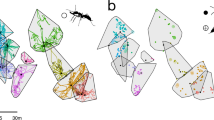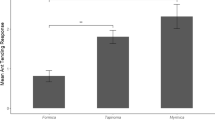Summary
The common North Temperate open-field antsLasius neoniger, Formica schaufussi, Myrmica americana, andMonomorium minimum overlap temporally in foraging activity as well as in the sizes of arthropod prey in their diets. Arthropod prey were taken by both individual workers and cooperative worker groups, and species differed in the proportion of prey in the diet retrieved by each method. Although prey size was significantly correlated with worker size for individually retrieved prey, when cooperative foraging was considered worker size did not serve as a consistent predictor of prey choice. Contrasting social strategies of foraging and the evolution of worker body size differences are discussed.
Resume
L'influence de la taille des ouvrières et du comportement coopératif sur l'activité de récolte a été analysé chez 4 fourmis communes de prairie de la zone tempérée nordaméricaine:Lasius neoniger, Formica schaufussi, Myrmica americana, etMonomorium minimum. Les niches de ces espèces se recouvrent au niveau de la taille de leurs proies (arthropodes) et de leur activité temporelle de récolte. Les arthropodes sont ramenés par des fourrageuses solitaires ou par des groupes d'ouvrières qui coopèrent. Les espèces diffèrent par les proportions de proies ramenées suivant l'une ou l'autre méthode. Dans le cas du transport solitaire, la taille des proies est corrélée à celle des fourrageuses, mais cette corrélation disparaît dans le cas du transport coopératif. Enfin, il est discuté les différentes stratégies sociales de fourragement et l'évolution de la taille des ouvrières.
Similar content being viewed by others
References
Adams E.A., Traniello J.F.A., 1981. — Chemical interference competition byMonomorium minimum.Oecologia, 51, 265–270.
Bernstein R., 1971. —The ecology of ants in the Mojave Desert: their interspecific relationships, resource utilization, and diversity. Ph. D. dissertation, University of California, Los Angeles.
Bernstein R., 1974. — Seasonal food abundance and foraging activity in some desert ants.Am. Nat., 108, 490–498.
Bernstein R., 1975. — Foraging strategies of ants in response to variable food density.Ecology, 56, 213–219.
Breise D.T., Macauley B.J. 1981. — Food collection within an ant community in semi-arid Australia, with special reference to seed harvesters.Austr. J. Ecol., 6, 1–19.
Brian M.V., Hible J., Stradling D.J., 1965. — Ant pattern and density in a southern English heath.J. Anim. Ecol., 34, 544–555.
Carroll C.R., Janzen D.H., 1972. — Ecology of foraging by ants.Ann. Rev. Ecol. Syst., 4, 231–257.
Chew R.M., Chew A.E., 1980. — Body size as a determinant of small-scale distribution of ants in evergreen woodland southeastern Arizona.Ins. Soc., 27, 189–202.
Chew R.M., DeVita J., 1980. — Foraging characteristics of a desert ant assemblage: functional morphology and species separation.J. Arid Env., 3, 75–83.
Culver D., 1974. — Species packing in Caribbean and north temperate ant communities.Ecology, 55, 974–988.
Davidson D. 1977a. — Species diversity and community organization in desert seed-eating ants.Ecology, 58, 711–724.
Davidson D., 1977b. — Foraging ecology and community organization in desert seed-eating ants.Ecology, 58, 725–737.
Davidson D., 1978. — Size variability in the worker caste of a social insect (Veromessor pergandei Mayr) as a function of the competitive environment.Am. Nat., 112, 523–532.
Goldstein E., 1973. —Ecology and biogeography of island ants. Ph. D. thesis. Yale University, New Haven, CT.
Heinrich B., 1978. — The economics of insect sociality. InBehavioral Ecology (eds. J. Krebs and N. Davies). Sinauer, Sunderland, MA.
Hespenheide H.A., 1973. — Ecological inferences from morphological data.Ann. Rev. Ecol. Syst., 4, 213–230.
Hespenheide H.A., 1975. — Prey characteristics and predator niche width. pp. 158–180. In:Ecology and Evolution of Communities (M.L. Cody and J.M. Diamond, eds.) Belknap Press, Cambridge, MA.
Hölldobler B., 1983. — Chemical manipulation, enemy specification and intercolony communication in ant communities. Chapter V. 3. In:Neuroethology and Behav-ioral Physiology (eds. F. Huber and H. Mark), Springer-Verlag, Berlin.
Hölldobler B., Stanton R., Markl H., 1978. — Recruitment and food-retrieving behavior inNovomessor (Hymenoptera: Formicidae). I. Chemical signals.Behav. Ecol. Sociobiol., 4, 163–181.
Lynch J.F., Balinsky E.C., Vail S.G., 1980. — Foraging patterns in three sympatric forest ant species,Prenolepis imparis Paratrechina melanderi, andAphaenogaster rudis Hymenoptera: Formicidae).Ecol. Entomol., 5, 353–371.
MacArthur R.A., Levins R., 1967. — The limiting similarity, convergence, and divergence of coexisting species.Am. Nat., 101, 377–385.
Oster G., Wilson E.O., 1978. —Caste and Ecology in the Social Insects. Princeton University Press, Princeton, NJ. xv +352 pp.
Rissing S.W., 1981. — Foraging specializations of individual seed-harvester ants.Behav. Ecol. Socobiol., 9, 149–152.
Rissing S.W., Pollock G.B., 1984. — Worker size variability and foraging efficiency inVeromessor pergandei (Hymenoptera: Formicidae).Behav. Ecol. Sociobiol., 15, 121–126.
Schoener T.W., 1974. — Resource partitioning in ecological communities.Science, 185, 27–39.
Talbot M., 1953. — Ants of an old-field community on the Edwin S. George Reserve, Livingston County, Michigan.Contributions from the Laboratory of Vertebrate Biology, Univ. Michigan, Ann Arbor,63, 1–13.
Traniello J.F.A., 1980. —Studies on the behavioral ecology of North Temperate ants. Ph. D. thesis Harvard University, Cambridge, Massachusetts.
Traniello J.F.A., 1983. — Social organization and foraging success inLasius neoniger Hymenoptera: Formcidae): behavioral and ecological aspects of recruitment communication.Oecologia, 59, 94–100.
Traniello J.F.A., Levings S.C., 1986. — Intra- and intercolony patterns of nest dispersion in the antLasius neoniger: correlations with territoriality and foraging ecology.Oecology., 69, 413–419.
Wehner R., Schmid-Hempel P., Harkness R.D., 1983. — Foraging Strategies in Individually Searching AntsCataglyphis bicolor. Gustav Fischer Verlag, Stuttgart.
Wilson D.S., 1975. — The adequacy of body size as a niche indicator.Am. Nat. 109, 769–784.
Wilson E.O., 1971. —The Insect Societies. Belknap Press of Harvard University Press, Cambridge, MA.
Author information
Authors and Affiliations
Rights and permissions
About this article
Cite this article
Traniello, J.F.A. Comparative foraging ecology of north temperate ants: The role of worker size and cooperative foraging in prey selection. Ins. Soc 34, 118–130 (1987). https://doi.org/10.1007/BF02223830
Received:
Accepted:
Published:
Issue Date:
DOI: https://doi.org/10.1007/BF02223830




